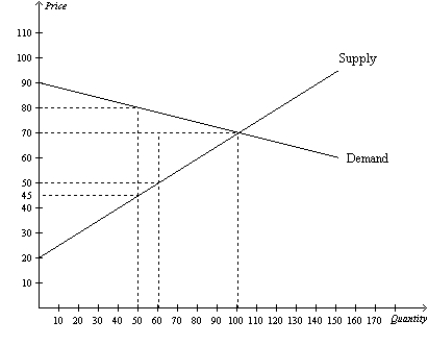A) only existing customers who now get lower prices on the gowns they were already planning to purchase.
B) only new customers who enter the market because of the lower prices.
C) both existing customers who now get lower prices on the gowns they were already planning to purchase and new customers who enter the market because of the lower prices.
D) Consumer surplus does not increase; it decreases.
F) None of the above
Correct Answer

verified
Correct Answer
verified
Multiple Choice
At Nick's Bakery, the cost to make homemade chocolate cake is $4 per cake. As a result of selling five cakes, Nick experiences a producer surplus in the amount of $17.50. Nick must be selling his cakes for
A) $6.50 each.
B) $7.50 each.
C) $9.50 each.
D) $10.50 each.
F) C) and D)
Correct Answer

verified
Correct Answer
verified
Multiple Choice
Figure 7-22  -Refer to Figure 7-22. If the price decreases from $80 to $70 due to a shift in the supply curve, consumer surplus increases by
-Refer to Figure 7-22. If the price decreases from $80 to $70 due to a shift in the supply curve, consumer surplus increases by
A) $250.
B) $750.
C) $1000.
D) $500.
F) A) and C)
Correct Answer

verified
Correct Answer
verified
Multiple Choice
ABC Company incurs a cost of 50 cents to produce a dozen eggs, while XYZ Company incurs a cost of 70 cents to produce a dozen eggs. Which of the following price increases would cause both companies to experience an increase in producer surplus?
A) The price of a dozen eggs increases from 40 cents to 55 cents.
B) The price of a dozen eggs increases from 55 cents to 70 cents.
C) The price of a dozen eggs increases from 55 cents to 75 cents.
D) All of these price increases would cause both companies to experience a loss in producer surplus.
F) A) and C)
Correct Answer

verified
Correct Answer
verified
Multiple Choice
Which of the following is correct?
A) Consumer surplus refers to a situation in which there are more buyers than sellers in a market.
B) Producer surplus refers to a situation in which there are more sellers than buyers in a market.
C) Total surplus is measured as the area below the demand curve and above the supply curve, up to the equilibrium quantity.
D) All of the above are correct.
F) None of the above
Correct Answer

verified
Correct Answer
verified
Multiple Choice
Table 7-16  -Refer to Table 7-16. Both the demand curve and the supply curve are straight lines. At equilibrium, producer surplus is
-Refer to Table 7-16. Both the demand curve and the supply curve are straight lines. At equilibrium, producer surplus is
A) $24.
B) $32.
C) $48.
D) $64.
F) All of the above
Correct Answer

verified
Correct Answer
verified
Multiple Choice
Table 7-5
For each of three potential buyers of oranges, the table displays the willingness to pay for the first three oranges of the day. Assume Allison, Bob, and Charisse are the only three buyers of oranges, and only three oranges can be supplied per day.  -Refer to Table 7-5. If the market price of an orange increases from $0.70 to $1.40, then consumer surplus
-Refer to Table 7-5. If the market price of an orange increases from $0.70 to $1.40, then consumer surplus
A) increases by $2.60.
B) decreases by $0.70.
C) decreases by $2.50.
D) decreases by $2.60.
F) All of the above
Correct Answer

verified
Correct Answer
verified
Showing 541 - 547 of 547
Related Exams